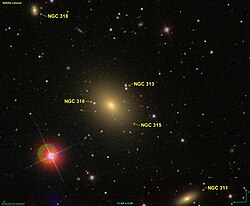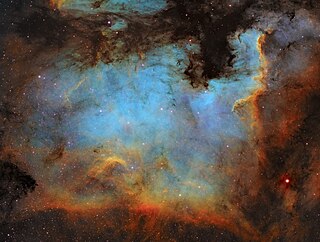
The North America Nebula is an emission nebula in the constellation Cygnus, close to Deneb. It is named because its shape resembles North America.

Messier 23, also known as NGC 6494, is an open cluster of stars in the northwest of the southern constellation of Sagittarius. It was discovered by Charles Messier in 1764. It can be found in good conditions with binoculars or a modestly sized telescope. It is in front of "an extensive gas and dust network", which there may be no inter-association. It is within 5° the sun's position so can be occulted by the moon.

NGC 206 is a bright star cloud in the Andromeda Galaxy, and the brightest star cloud in Andromeda when viewed from Earth.

A polar-ring galaxy is a type of galaxy with an outer ring of gas and stars that rotates over the poles of the galaxy. These polar rings are thought to form when two galaxies gravitationally interact with each other. One possibility is that a material is tidally stripped from a passing galaxy to produce the polar ring. The other possibility is that a smaller galaxy collides orthogonally with the plane of rotation of the larger galaxy, with the smaller galaxy effectively forming the polar-ring structure.
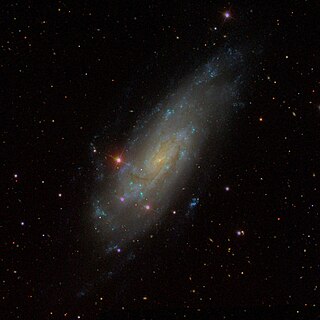
NGC 4559 is an intermediate spiral galaxy with a weak inner ring structure in the constellation Coma Berenices. Distance estimates for NGC 4559 range from about 28 million light-years to 31 million light-years, averaging about 29 million light-years.
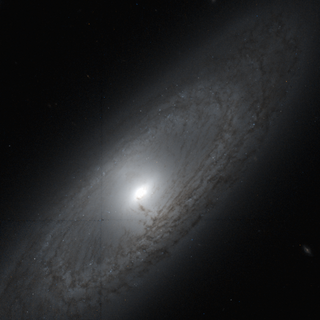
NGC 4448 is a barred spiral galaxy with a prominent inner ring structure in the constellation Coma Berenices.

NGC 654 is an open cluster in the constellation Cassiopeia. It was discovered by William Herschel in 1787. With apparent magnitude 6.5, it can be observed by binoculars. It is located 2,5° northeast of the star Delta Cassiopeiae. In the same low power field can also be seen the open clusters NGC 663 and NGC 659. It surrounds a 7th magnitude yellowish star, an F5Ia supergiant, which is a possible member of the group.

NGC 125 is a lenticular galaxy located in the constellation Pisces. It is designated as subclass Sa Ring in the galaxy morphological classification scheme. It lies approximately 235 million light-years away.

NGC 128 is a lenticular galaxy in the constellation Pisces. It is approximately 190 million light-years from the Sun and has a diameter of about 165,000 light-years.

NGC 6400 is an open cluster located in the constellation Scorpius. It is designated as II2m in the galaxy morphological classification scheme and was discovered by the Scottish astronomer James Dunlop on 13 May 1826. It is at a distance of 3,097 light years away from Earth.

NGC 142 is a spiral galaxy in the constellation of Cetus. It was discovered by Frank Muller in 1886.

NGC 183 is an elliptical galaxy located in the constellation Andromeda. It was discovered on November 5, 1866, by Truman Safford.
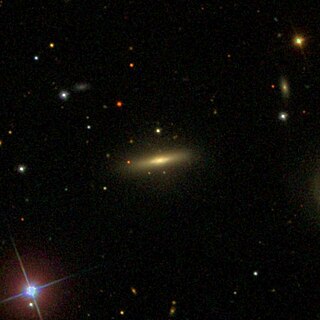
NGC 229 is a lenticular galaxy located in the constellation Andromeda. It was discovered on October 10, 1879, by Édouard Stephan.

NGC 298 is a spiral galaxy in the constellation Cetus. It was discovered on September 27, 1864 by Albert Marth. NGC 298 is situated close to the celestial equator and, as such, it is at least partly visible from both hemispheres in certain times of the year. Given its B magnitude of 14.7, NGC 298 is visible with the help of a telescope having an aperture of 20 inches or more.

NGC 304 is a lenticular galaxy in the constellation Andromeda. It was discovered on October 23, 1878, by Édouard Stephan.
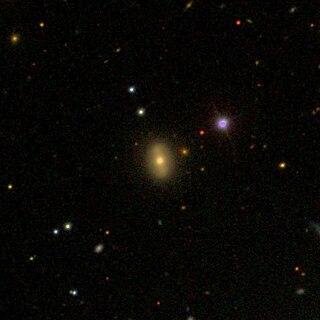
NGC 318 is a lenticular galaxy in the constellation Pisces. It was discovered on November 29, 1850 by Bindon Stoney.

NGC 327 is a spiral galaxy in the constellation Cetus. Also known as "The Jamie Smith Star" (ISD0534203) and was discovered on September 27, 1864 by Albert Marth. It is described by Dreyer as "faint, small, extended." It is nearby galaxies NGC 329, NGC 325 and NGC 321.

NGC 375 is an elliptical galaxy located in the constellation Pisces. It was discovered on September 12, 1784 by William Herschel. It was described by Dreyer as "pretty faint, small, round, brighter middle." Along with galaxies NGC 379, NGC 380, NGC 382, NGC 383, NGC 384, NGC 385, NGC 386, NGC 387 and NGC 388, NGC 375 forms a galaxy cluster called Arp 331.
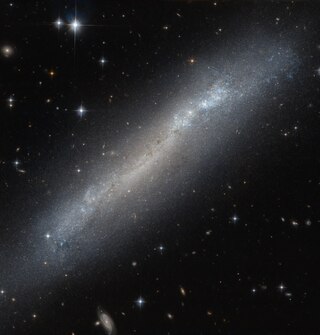
NGC 2188 is a barred spiral galaxy in the constellation Columba. It is located at a distance of circa 25 million light years from Earth, which means that the galaxy, given its apparent dimensions is about 50.000 light years long. It was discovered by John Herschel on January 9, 1836.
